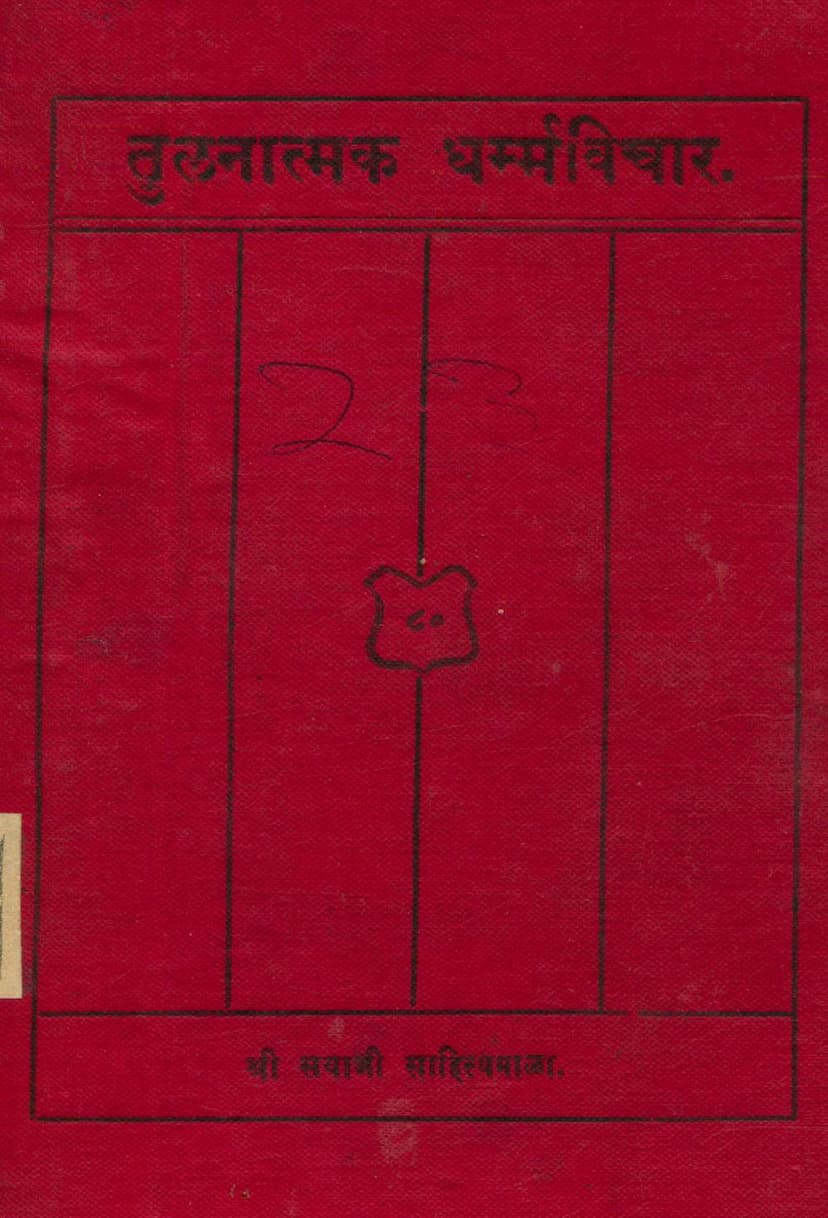Tulnatmak Dharma Vichar
Added to library: September 2, 2025

Summary
This document is a summary of the Jain text "Tulnatmak Dharma Vichar" (Comparative Religious Thought) by Rajyaratna Atmaram, published by Jaydev Brothers in 1921. The book is a Hindi translation of F. B. Jevons' "Comparative Religion," and it aims to foster the growth of literature in indigenous languages.
The text is organized into several chapters, each exploring different aspects of religious thought:
1. Introduction (Prastavana): This chapter emphasizes the need for comparative religious studies, highlighting that by understanding the similarities and differences between religions, one can gain deeper insights. It discusses the human quest to understand their relationship with the divine and categorizes religions into those with written histories (e.g., Egyptian, Vedic, Buddhist, Christian) and those without. It also touches upon the concept of self-preservation as a fundamental rule of creation and the development of societal cooperation.
2. Sacrifice (Yajna): This chapter delves into the origins, evolution, and forms of "Yajna" (sacrifice/ritual), a central concept in many religions. It clarifies the often misunderstood meaning of the word "Yajna," tracing its etymological roots and asserting that its original meaning was not associated with violence or animal sacrifice but rather with righteous actions and devotion. The author highlights the multifaceted nature of Vedic knowledge, encompassing knowledge, action, and worship, and contrasts this with other religions that often focus primarily on worship or actions. It also discusses the significance of "Yajna" in the Vedic tradition, its association with pleasing deities, and the evolution of sacrificial practices over time, including the introduction of animal sacrifices which the author argues were later corruptions of the original Vedic intent. The chapter also explores the connection between "Yajna" and agricultural and pastoral practices, as well as the symbolic meaning of offerings.
3. Magic (Jadu): This section differentiates between magic and religion, suggesting that magic is primarily individualistic, while religion is concerned with society and the broader community. It explains how in early societies, illness and death were often attributed to the actions of sorcerers or witches, leading to the development of magical practices and rituals to ward off or counteract these perceived evils. The chapter notes that while magic focuses on individual desires and often involves harmful practices, religion aims to maintain social order and appease deities for the collective good. It also discusses how, in some instances, magic and religion became intertwined, with magical practices incorporated into religious rituals.
4. Ancestor Worship (Pitri Puja): This chapter examines the concept of life after death and the practice of ancestor worship across various cultures. It discusses the belief in the continuity of the soul after the body's demise and how this belief has manifested in different religious traditions, including the practice of offering to ancestors. The author notes that while many religions focus on appeasing deities, ancestor worship specifically addresses the relationship with deceased family members. It highlights the prominence of ancestor worship in Chinese culture and its historical development. The chapter also touches upon the debate regarding the nature of the soul and its existence after death, drawing parallels between different religious beliefs.
5. Life After Death (Bhavi Jivan): This section explores the diverse conceptions of the afterlife across different religions. It discusses the belief in the continuity of individual existence after death and the various forms this belief takes, including reincarnation, resurrection, and heavenly or hellish realms. The chapter emphasizes that regardless of the specific beliefs, the idea of a life beyond death serves to provide meaning and purpose to human existence and to regulate moral behavior. It highlights how different religions offer solace, hope, and a framework for understanding the human condition in the face of mortality.
6. Dualism (Dvandva): This chapter delves into the concept of dualism, a philosophical and theological framework that posits the existence of two fundamental, opposing forces or principles, often good and evil. It explores how dualistic concepts have manifested in various religious traditions, particularly in Zoroastrianism, where the struggle between the benevolent deity Ahura Mazda and the malevolent spirit Angra Mainyu is central. The chapter analyzes the development of dualistic thought, its impact on religious practices and beliefs, and how it shapes the understanding of the world as a battlefield between opposing forces.
7. Buddhism: This chapter provides an overview of Buddhism, focusing on its core tenets and philosophical underpinnings. It highlights the Buddha's emphasis on the cessation of suffering (dukkha) through the elimination of desire and attachment. The chapter discusses the concept of Nirvana, the cycle of rebirth (samsara), and the importance of ethical conduct and meditation in achieving liberation. It also touches upon the historical development of Buddhism and its spread across different cultures, noting its unique approach to the concept of God and the soul.
8. Monotheism (Ekeshwarvad): This chapter examines the concept of monotheism, the belief in one God, as it has evolved across various religions. It discusses the progression from animism and polytheism to monotheistic beliefs, tracing the historical development of this concept through Judaism, Christianity, and Islam. The chapter highlights the shared features of monotheistic religions, such as the belief in a supreme being, divine revelation, and the importance of moral conduct. It also explores the different interpretations and expressions of monotheism in various traditions, as well as the challenges and criticisms associated with this belief system.
The book concludes with a comprehensive list of other published works by Jaydev Brothers.
Overall, "Tulnatmak Dharma Vichar" offers a comparative analysis of key religious concepts, exploring their historical origins, evolution, and diverse manifestations across different cultures and traditions. It aims to foster a deeper understanding and appreciation of the common threads that bind humanity's spiritual quest, as well as the unique pathways that different religions have taken.